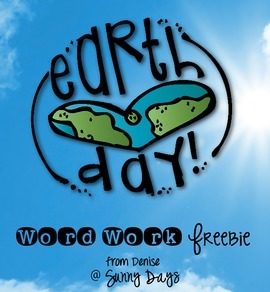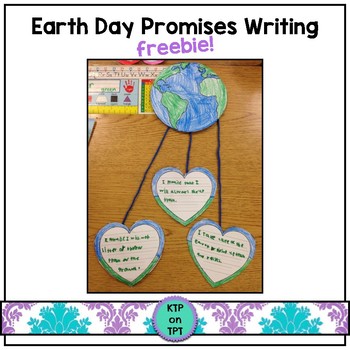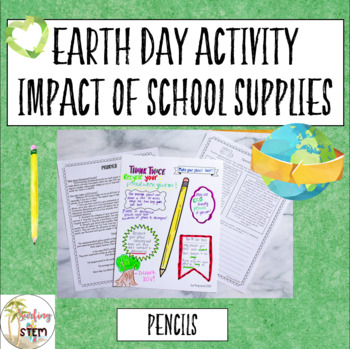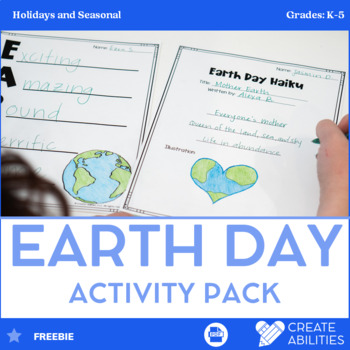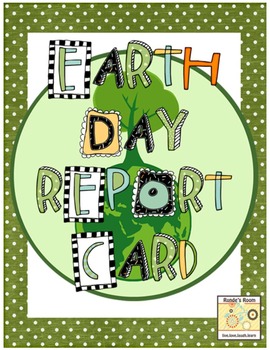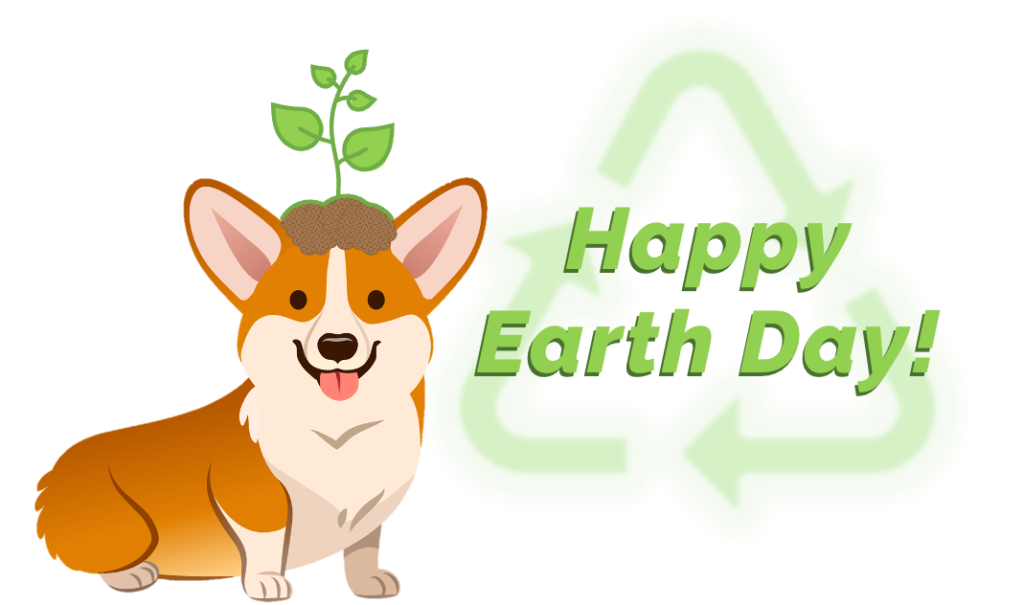
We’ve curated several Earth Day activities for students that celebrate the holiday while helping students build their ELA skills! Earth Day is on Tuesday, April 22, 2025—keep reading to explore some ideas on how your classroom can celebrate!
Students care deeply about the environment. They know about climate change and the ways that humans harm the environment, causing them concern for the well-being of the planet. Even from a young age, they know that they want to grow up in a clean, safe world!
This is why bringing Earth Day celebrations into the classroom is vital. By teaching students about the environment and encouraging them to reduce, reuse, and recycle, they’ll learn how each individual has an impact on the world around them and understand their responsibility to help keep it clean and green!
ELA Earth Day Activities for Students
Reading, writing, and language skills are honed with practice! Use these Earth Day-themed worksheets and activities as a fun accompaniment to your existing ELA lesson plans to excite students about the environment.
Elementary Level Earth Day ELA Activities for Students
The following inspiring activities for elementary school students are sure to motivate children to build green habits while helping them practice their ELA skills. A few of them call upon students for their creativity and coloring skills, producing some decorating ideas for the classroom!
1. Earth Day Word Work – Free Vocabulary Activity
This Earth Day Language Arts resource is all about environmental vocabulary! It comes with three printable Earth Day activities, along with answer sheets for easy grading. Each activity encourages students to practice their word-learning skills in different ways, all thematically tied to environmental issues and conservation ideas.
The first worksheet focuses on word spelling and sounds, asking students to list words alphabetically, identify misspelled words, and more. The second focuses on meaning, asking students to match vocabulary words with their definitions—it also includes a mini-word search! The final activity engages with students’ visual learning skills and asks them to match words with the shapes their letters create. Each of these fun activities strengthens students’ vocabulary acquisition skills in a different way, all while emphasizing the importance of caring for the environment!
Created and made available for free download by SunnyDays.
2. Parts of Speech Earth Day Worksheets
This free resource is a colorful way to engage students in ELA instruction and educate them on environmental issues! Students will demonstrate their knowledge of parts of speech while coloring in a pop art recycling-themed image. This activity contains both beginner and intermediate versions of a worksheet defining parts of speech, prompting students for their own examples, as well as a “paint-by-word” image of a recycling symbol.
This teacher-friendly resource is complete with instructions on introducing the activity, ideas for displaying students’ beautiful work, and answer sheets!
Created and made available for free download by Art with Jenny K.
3. Earth Day Promises Writing Activity
This creative activity calls upon students to make their own commitments to our beautiful planet Earth! Provided is a template for the globe-and-hearts graphic to the right—students will have the opportunity to color their globe and decorate their hearts as well as practicing their writing skills within the hearts. The resource creator offers sample sentence-starters to inspire students’ writing, but how you prompt them is up to you!
The commitments students will write showcase reading comprehension and vocabulary skills (if paired with an Earth Day-themed textual task, such as a reading on conservation prior to this activity) as well as their writing capabilities! Another fun way to engage students and decorate classrooms for Earth Day, this activity even has a digital version for remote learning.
Created and made available for free download by KTPonTPT.
Reading and Writing Earth Day Activities for Middle and High Schoolers
The following free Earth Day activities for students in 6th–12th grade emphasize the importance of making your own well-informed choices about eco-friendliness while also providing several opportunities for critical thinking and writing practice!
1. School Supply Sustainability Activity
Even though a significant amount of learning today takes place through laptops and phones, overconsumption and waste is still a pressing issue. This activity hones students’ reading comprehension, argumentative writing, and creativity skills as they learn about the sustainability behind school supplies!
This resource is wonderful because it includes several activities you can pick and choose from to assign what is best for your classroom. Students can be assigned a two-page nonfiction text to read about the environmental impacts of wasted school supplies, followed by several reading comprehension questions. If your class is in need of persuasive writing practice, consider the two short paired passages demonstrating opposing opinions concerning whether mechanical pencils are a suitable alternative to wooden pencils—students would then be tasked to write their own argumentative passage on the issue. At the end, a page is provided for them to create a “campaign poster” based on what they’ve learned!
Created and made available for free download by Surfing and STEM.
2. Earth Day Poetry and Writing Activities
This Earth Day activity for students is great for any grade level! Students are assigned several environment-themed writing activities, including creating anagram poems, creating a haiku, and writing about ways to help the Earth.
Creative writing is just as important as research or opinion writing in students’ ELA education—through writing creatively, they are able to implement rhetorical or figurative devices, explore a variety of writing structures, connect multiple ideas on their own, and understand fiction from a new perspective. Writing poetry also helps them learn rhyme, figurative language, and other literary tools. This activity pack encourages them to explore their own unique vocabulary, thoughts, and ideas while discussing the integral issue of protecting the planet!
Created and made available for free download by Create-Abilities.
3. Earth Day Report Card
This final free Earth Day activity continues to encourage students to actively participate in keeping their own environments green-friendly. This resource consists of three different “report cards” that allow students to evaluate how “green” their school, classroom, or home is. For example, on the “school” report card, students should mark off whether or not “There is a school-wide recycling program for paper” or “There are plants within the school for air quality”.
Students can be split into groups to complete either the “school” or “classroom” report card and can be assigned the “home” report card as homework. This activity encourages students to look at the many different aspects of keeping their spaces eco-friendly while providing an opportunity for them to practice writing! Two additional worksheets ask students for suggestions about making the classroom or school a greener place and what students can do themselves to help it happen. An additional writing prompt that asks students to elaborate further on their answers could be a great accompaniment to this assignment!
Created and made available for free download by Runde’s Room.
Earth Day Reading Comprehension Questions by Piqosity
Looking for more reading comprehension practice? Here at Piqosity, we have full online ELA courses for grades 5-11, each complete with a multitude of nonfiction and fiction passages with reading comprehension questions to test students and help them practice their ELA skills. The following passage is from Unit 3 of our 8th Grade English course, included here as a bonus Earth Day-themed ELA activity! These reading comprehension questions, each covering a variety of ELA subtopics, quiz students on their English knowledge while they read about the environmental concern of deforestation.
Excerpt Adapted from Slowing Deforestation by Adam Wernick

Reading Comprehension Questions
1. Why is COVID-19 considered a zoonotic disease?
A. It started in Asia.
B. It is a human disease that originated in animals.
C. It is a direct result of deforestation.
D. It is a result of climate change.
2. Select the answer choice that is not described in the article as a reason to slow deforestation.
A. Preventing emerging diseases.
B. Protecting biodiversity.
C. Preventing flooding.
D. The carbon value of forests.
3. The purpose of the seventh paragraph (lines 69-80) is to…
A. Explain how deforestation leads to zoonotic diseases.
B. Urge people to stop the wildlife trade and to campaign against deforestation.
C. Describe the importance of surveillance on the wildlife trade and people in close proximity to wildlife.
D. Explain why billions of dollars should be spent on reducing deforestation, addressing the wildlife trade, and improving surveillance.
Passage Answer Key and Explanations
1. B.
The passage describes what zoonotic diseases are in the first paragraph: “Many human diseases originate in animals: HIV, malaria, Lyme disease and, of course, COVID-19. Scientists call them zoonotic diseases,” (lines 1-3). Therefore, “It is a human disease that originated in animals.” is correct.
Even if you didn’t look back at the passage for this answer, another way you can deduce this answer is through evaluating what “zoonotic” as a word means. “Zoo” is a Greek root that means “animal” – even if you didn’t know this, you can see the correlation with the nouns “zoo” or “zoology” and “zo-” of “zodiac” (the zodiac is composed of 12 animals). By using this clue in the word parts, you can figure out that a zoonotic disease has something to do with animals and select the applicable answer choice.
2. C.
The article focuses on “preventing emerging diseases” as its core reason to stop deforestation, which makes that answer incorrect.
It also names several other reasons to slow deforestation: “Dramatically reducing deforestation and the wildlife trade would have other valuable benefits, such as saving crucial carbon sinks like the tropical forests and protecting global biodiversity,” (lines 44-46). Thus, because they are clearly described in the article, “Protecting biodiversity” and “The carbon value of forests” are both incorrect answer choices.
The correct answer choice is “Preventing flooding” – the article describes that forests are important to water resources, but it does not describe the effect of deforestation on flooding.
3. D.
“Explain why billions of dollars should be spent on reducing deforestation, addressing the wildlife trade, and improving surveillance.” is correct. The seventh paragraph discusses the budgeting of Dr. Bernstein’s proposed project, saying that it “…would cost between $20 to $30 billion,” (line 73). However, it goes on to describe that if this money was spent every year for a decade, that it’d only be less than 2% of the cost of managing the COVID-19 pandemic. By comparing these statistics, the quoted Dr. Bernstein is urging the public to understand that by investing in wildlife and forest conservation projects, they are mitigating (reducing) the risk of another dangerous and costly disease (or, potentially, another pandemic).
Earth Day-Themed Math Activities
Learning about the environment through math activities can help students strengthen their green thumb and math skills! Plus, this day of recognition is a great way to get students of any grade level excited about STEM concepts.
Earth Day Math Activities for Elementary Students
These next environmental activities are fun ways to get younger students engaged with basic operations and fractions!
1. Tree-Loving Basic Operations Games
 Have early elementary students that are practicing their order of operations? These printable Earth Day activities test students’ addition, subtraction, and multiplication skills in a gamified way! All you need to do to get students practicing is to split them into groups of 2–4, provide counters and dice, and print out one worksheet per group! (Green tip: Since students won’t need to mark the pages, laminate them to use next year!)
Have early elementary students that are practicing their order of operations? These printable Earth Day activities test students’ addition, subtraction, and multiplication skills in a gamified way! All you need to do to get students practicing is to split them into groups of 2–4, provide counters and dice, and print out one worksheet per group! (Green tip: Since students won’t need to mark the pages, laminate them to use next year!)
Presented with a board of hexagons labeled with numbers, the “Plant a Tree” sheet tasks students to take turns rolling two dice, then adding or subtracting those results to “plant” their tree on a matching space—the student to plant a tree in the last hexagon is the winner. (The “Save a Tree” activity is the same concept, but with doubling or tripling the result of the dice.)
Created and made available for free download by Games 4 Learning.
2. Earth Day Comparing Fractions Activity
 Being able to compare the sizes of basic fractions is a crucial math skill for early-mid elementary students. This activity will help them visualize fractions and get familiar with the idea that larger denominators indicate smaller portions with a fun, flower theme.
Being able to compare the sizes of basic fractions is a crucial math skill for early-mid elementary students. This activity will help them visualize fractions and get familiar with the idea that larger denominators indicate smaller portions with a fun, flower theme.
Students are tasked with six questions asking them to compare fractions with the same numerator using symbols (>, <, =). This simple activity is great for filling the gaps between lessons or as short, end-of-day practice. Consider printing the black and white versions if you have more time for students to color in the flowers!
Created and made available for free download by Talented in Third.
3. Long Division Digital Color-by-Number Earth Day Cartoon
 Mostly used by 4th and 5th grade classrooms, this color-by-number is a fantastic way for students to satisfyingly “color in” an Earth Day-themed cartoon—without the need for crayons or markers! This fully-digital activity in Google Sheets is perfect for classrooms using digital assignments: access the link at the top of the PDF’s second page to make your own copy of the file and follow the document’s instructions on easily distributing it to your students!
Mostly used by 4th and 5th grade classrooms, this color-by-number is a fantastic way for students to satisfyingly “color in” an Earth Day-themed cartoon—without the need for crayons or markers! This fully-digital activity in Google Sheets is perfect for classrooms using digital assignments: access the link at the top of the PDF’s second page to make your own copy of the file and follow the document’s instructions on easily distributing it to your students!
Students are tasked with fourteen long division problems, which they’ll solve on their own paper before typing their answer in. With each correct answer, one section of the picture is colored in until it’s complete!
Created and made available for free download by Inspire Math Matematyka.
Middle and High School–Level Earth Day Math Activities
These final free math activities are fun, environment-themed ways to strengthen middle and early high school students’ skills in coordinate planes as well as factors and multiples.
1. Earth Day Challenge Ordered Pairs Game
 Middle school or Algebra students learning about the coordinate plane will have a great time competing to see who can “pick up trash” the most efficiently. Each student will get a sheet with an identical coordinate plane with images of trash scattered around and be tasked with drawing a path between the pieces of trash. The goal is to get the most points based on the trash you pick up and have a shorter path than others. Meanwhile, they must also take note of the coordinates of each piece of trash they picked up.
Middle school or Algebra students learning about the coordinate plane will have a great time competing to see who can “pick up trash” the most efficiently. Each student will get a sheet with an identical coordinate plane with images of trash scattered around and be tasked with drawing a path between the pieces of trash. The goal is to get the most points based on the trash you pick up and have a shorter path than others. Meanwhile, they must also take note of the coordinates of each piece of trash they picked up.
This activity, available for both digital and print distribution, gives students the opportunity to get familiar with a coordinate plane and ordered pairs in a low-pressure format. This kind of friendly competition in a class game encourages everyone to participate with their best effort!
Created and made available for free download by Inspire Math Matematyka.
2. Factors and Multiples—The Importance of Bees Activity
 Bees are vital to our environment because they pollinate plants, necessary for the growth of vegetation. This easy-to-use activity brings attention to the amount of pollinating bees do (One bee can pollinate up to 5,000 flowers a day!), while helping your students practice key middle school math skills.
Bees are vital to our environment because they pollinate plants, necessary for the growth of vegetation. This easy-to-use activity brings attention to the amount of pollinating bees do (One bee can pollinate up to 5,000 flowers a day!), while helping your students practice key middle school math skills.
Understanding factors and multiples is as important to a student’s readiness for higher level math as bees are to our environment! This activity simply asks students to find the highest common factor or lowest common multiple between given numbers—the amount of flowers certain bees pollinate a day. A great bellringer or exit ticket, these five questions present a quick learning opportunity that’s fitting with the spring season and Earth Day.
Created and made available for free download by KSephton3.
3. Keeping Clean by Graphing Linear Equations
 Similar to the first activity for older math students in this collection, this resource presents students an opportunity to “pick up trash” on a coordinate plane. However, this resource is more fitting for 8th grade or Algebra students—students will be graphing linear equations on their quest to clean up the coordinate plane!
Similar to the first activity for older math students in this collection, this resource presents students an opportunity to “pick up trash” on a coordinate plane. However, this resource is more fitting for 8th grade or Algebra students—students will be graphing linear equations on their quest to clean up the coordinate plane!
Participants will be tasked with graphing twelve slope-intercept form equations on their coordinate plane, matching the equation with the type of trash it picked up. While the graphing game above involves competition with the whole class, this assignment is a more low-key opportunity to practice graphing and linear equations while keeping up an eco-friendly-theme—perfect for classes getting the hang of y=mx+b!
Created and made available for free download by MadeByMoog.
Original Piqosity Earth Day Math Quiz
Looking for more math practice for your students? Here at Piqosity, we have full online math courses for grades 5-11, each complete with a multitude of practice questions, lessons, and more! To celebrate Earth Day, our team has developed this short math quiz with themed questions geared towards middle and high school students.
1. A plant store is donating 22% of their profits from Earth Day and the day after, splitting the donation between two animal conservation organizations. On Earth Day, they earned $52,940 in profits, and they profited $39,602 the day after. Approximately how much money will the store donate to each animal conservation organization?
A. $11,647
B. $10,180
C. $13,620
D. $20,360
2. The Amazon rainforest is the largest and most biodiverse tropical rainforest on Earth; as a result, it’s vital to our planet’s environments and climate.
In 1977, the Amazon spanned 4,100,001 square kilometers. By 2000, 86% of that forest cover remained—by 2022, 6% more was deforested. If the deforestation occurred at a constant rate over those 22 years, about how many square kilometers of the Amazon forest was lost each year?
A. 20,107 km²
B. 11,181 km²
C. 14,530 km²
D. 26,090 km²
3. Caroline decided to plant 3 peonies in her backyard last Earth Day. Over the past year, the amount of peonies grew exponentially at a rate of 90%. Which of the following is equal to the approximate number of peonies in Caroline’s backyard after one year?
A. 15
B. 5
C. 12
D. 7
Answer Key and Explanations
1. B.
The question is looking for the amount of money donated to each animal conservation organization. The store is donating 22% of profits across two days, splitting it equally between the two organizations.
To calculate this, first find the total profits across the two days.
$52,940 + $39,602 = $92,542
Find 22% of this total by converting the percent into a decimal then multiplying them.
$92,542 x 0.22 = $20,359.24
The store donated a total of $20,359.24 to the two organizations. Split this number in half to find the answer.
$20,359.24 / 2 = $10,179.62
Round your answer to the one’s place—$10,180 is the correct answer.
2. B
The question asks how much of the Amazon was lost over the course of 22 years, 2000-2022. It states that 6% of the rainforest was lost between 2000 and 2022. This is the most straightforward way to find how much of the rainforest was lost each year:
Find 6% of the original size of the Amazon (4,100,001) by converting the percentage to a decimal before multiplying them.
4,100,001 x .06 = 246,000
So, 246,000km² of the Amazon was lost between 2000 and 2022.
Now, divide this by 22 to find the amount lost each year.
246,000 / 22 = 11,181.8
3. D
The population of peonies is growing at an exponential rate. To calculate the number of peonies present after 1 year, we will need to use the exponential growth formula:
Where A is the target or final value, P is the principal or initial value, e is Euler’s number (approximately equal to 2.718), r is the growth rate and t is the number of years over which we are evaluating.
In this case, our growth rate is 90%. Convert this value to a decimal (90% = 0.9) before plugging it into the formula.
Use order of operations to solve for A, using 2.718 as e.
(.9)(1)=.9
3 × 2.459 = 7.37
This means that there will be approximately 7 peonies in Caroline’s backyard after one year.
Find More ELA and Math Resources Like These at Piqosity!
We hope you found the above Earth Day activities for students insightful and resourceful for your classroom, both in their fun and engaging celebration of the holiday and in the plentiful opportunities to sharpen key ELA and Math skills for students.
You can find more (non-themed) reading, writing, and math lessons with questions of similar difficulty levels in our courses! Along with our Digital SAT and ACT test prep courses, each packed with several full-length practice tests, we also offer full-length online English and Math courses—each course includes dozens of concept lessons, personalized practice software, and practice tests with step-by-step answer explanations.
The best part? You can try out all of Piqosity’s features with our free community account, which features a free mini diagnostic exam to evaluate your current math skills. When you’re ready to upgrade, Piqosity’s year-long accounts start at only $89.


